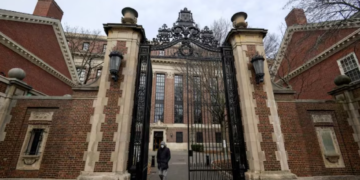Navy Secretary Carlos Del Toro signs a proclamation exonerating 256 Black sailors convicted for refusing to resume work after the Port Chicago explosions in July 1944. (Craig Hudson for The Washington Post
July 18, 2024 Story by: Editor
Eighty years after explosions devastated the Port Chicago naval facility in California, killing 320 sailors, Coast Guard personnel, and civilians, the Secretary of the Navy has announced the full exoneration of African American sailors who were charged with mutiny in 1944. These sailors had refused orders to return to dangerous work conditions loading ammunition.
Navy Secretary Carlos Del Toro stated that the decision to exonerate the sailors came after a Navy investigation revealed legal errors in the 1944 court-martial trial of 256 Black sailors. These sailors had been threatened with execution for refusing to return to work following the July 17, 1944, explosions.
The cause of the explosions, which injured over 400 people, destroyed two ships and a train, and flattened the nearby town of Port Chicago, was never determined. According to Navy historians, the disaster at Port Chicago was the single worst home-front disaster during World War II.
After the explosions, white supervising officers were given hardship leave, while Black sailors who survived were ordered back to work loading ammunition. Due to the hazardous conditions and lack of training, hundreds of Black sailors, who faced racism in a segregated Navy, refused to return to work. Fifty were charged with mutiny, and 208 were charged with disobeying orders.
“The charges were a tremendous wrong that has haunted many survivors and their family members,” Del Toro told The Washington Post. “I have made the decision to set aside the court-martial results of all sailors convicted as part of the Port Chicago incident.”
Del Toro emphasized that the exoneration “clears their names, restores their honor, and acknowledges the courage they displayed in the face of immense danger.”
At the time, Navy personnel policies barred Black sailors from most seagoing jobs, so the battalions at Port Chicago were largely composed of Black enlisted personnel and white officers. Black sailors worked under perilous conditions, loading ships with ammunition in grueling 24-hour shifts. The white officers supervising them often placed bets on which shifts could load more ammunition.
The exoneration announced Wednesday covers 256 of the 258 sailors convicted in 1944. The remaining two sailors’ convictions had already been set aside by former Navy secretaries due to insufficient evidence and a determination that one sailor did not have the capacity to understand the gravity of refusing orders.
The new investigation, ordered by Del Toro, who was sworn in as secretary in 2021, found that 258 African American sailors had been erroneously tried as a group in 1944. The legal review concluded the sailors had not been given appropriate counsel, with attorneys assigned to defend large groups of sailors grouped alphabetically.
“The trial lawyers did not have time to properly prepare for the case,” Navy general counsel Sean Coffey said.
The disaster at Port Chicago began around 10:19 PM on July 17, 1944, when two massive blasts obliterated the U.S. naval magazine at Port Chicago, California. Regina T. Akers, a historian at the Naval History and Heritage Command, described the incident.
The blasts destroyed two cargo ships, the SS Quinault Victory and the SS E.A. Bryan, which had been berthed at the pier where over 4,600 tons of ammunition, aerial bombs, high explosives, and smokeless powder were loaded.
The explosions demolished nearly everything within a 1,000-foot radius, including cargo ships, the port’s pier, boxcars, a 45-ton locomotive, a Coast Guard barge, and a wharf under construction. The impact was equivalent to 5,000 tons of TNT, akin to a 3.4-magnitude earthquake.
“Witnesses reported seeing an immense column of fire that mushroomed, creating a magnificent yellow-orange light,” Akers said.
The search for survivors quickly became a recovery mission. “Only 51 bodies remained intact for identification, and the smell of burning flesh hung in the air,” according to the Navy. Hundreds of the dead were unrecognizable. “All the men who survived were traumatized,” Akers noted. “They were asked to go through the debris to look for possible survivors. They ended up picking up limbs.”
Of the 320 people killed, 202 were Black sailors, representing one-fifth of all African American naval casualties during World War II.
Before the explosions, Black sailors had reported the dangerous conditions and requested work gloves, but the Navy refused. Some sailors wrote home asking their families to send gloves and contacted the NAACP and the National Urban League about the hazardous working conditions.
After the explosions, surviving sailors at Port Chicago were sent to Mare Island Naval Shipyard, 23 miles northeast of San Francisco. The Navy began an immediate investigation and summoned a court of inquiry, interviewing 120 witnesses. The 39-day investigation ended with the Navy clearing all white officers at Port Chicago of any culpability.
The Navy declared it could not confirm the exact cause of the initial explosion. However, the court’s 1,200-page report implied that the African American ammunition handlers might have contributed to the blast.
“Eventually, they got an order to go back to work,” Akers said. “They were very concerned that another explosion might occur unless there was a change in procedures and policies. That was the chief reason for not wanting to return.”
After expressing concerns about the dangerous conditions, 258 sailors were arrested and confined to a large barge. They were threatened with prosecution, court-martial, and execution if they refused to return to work.

















